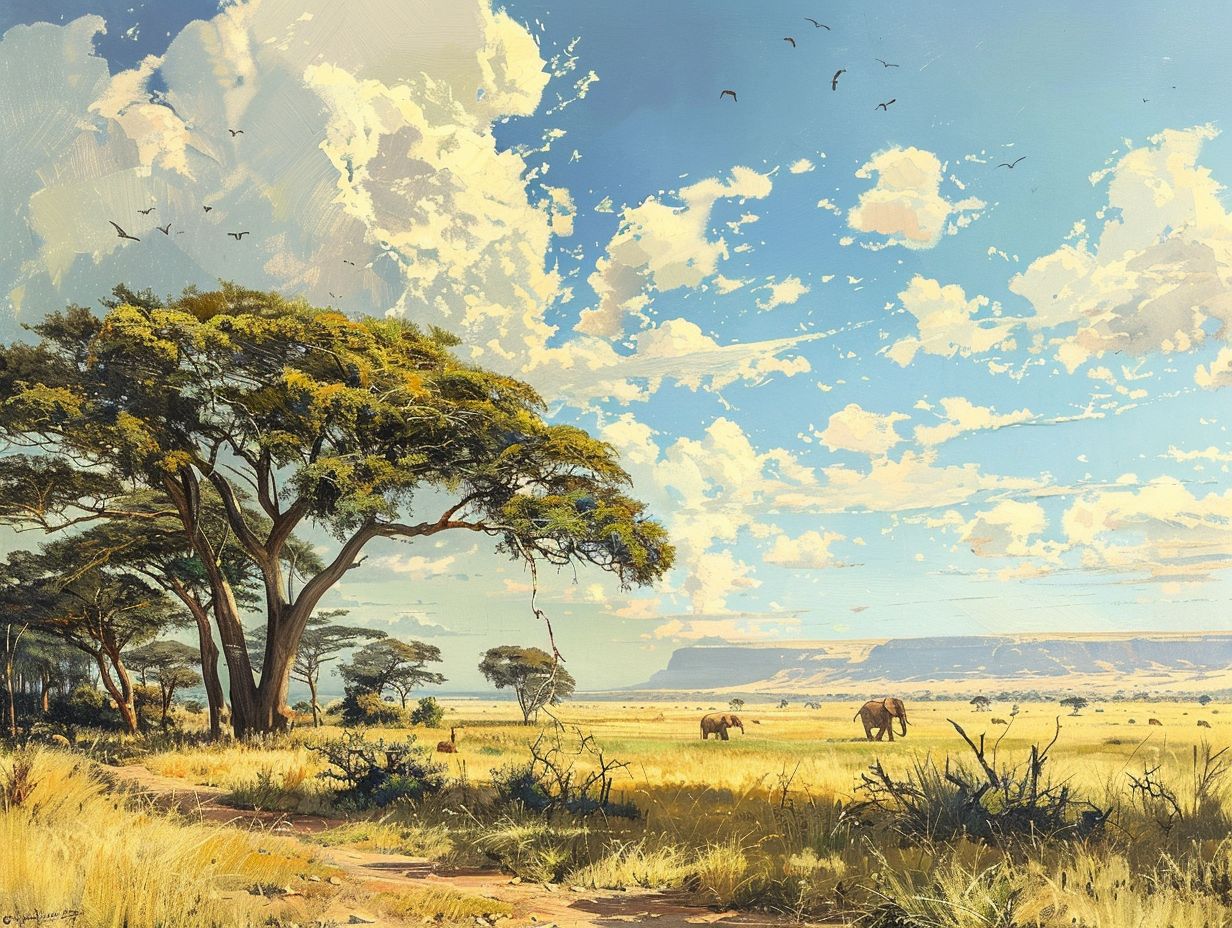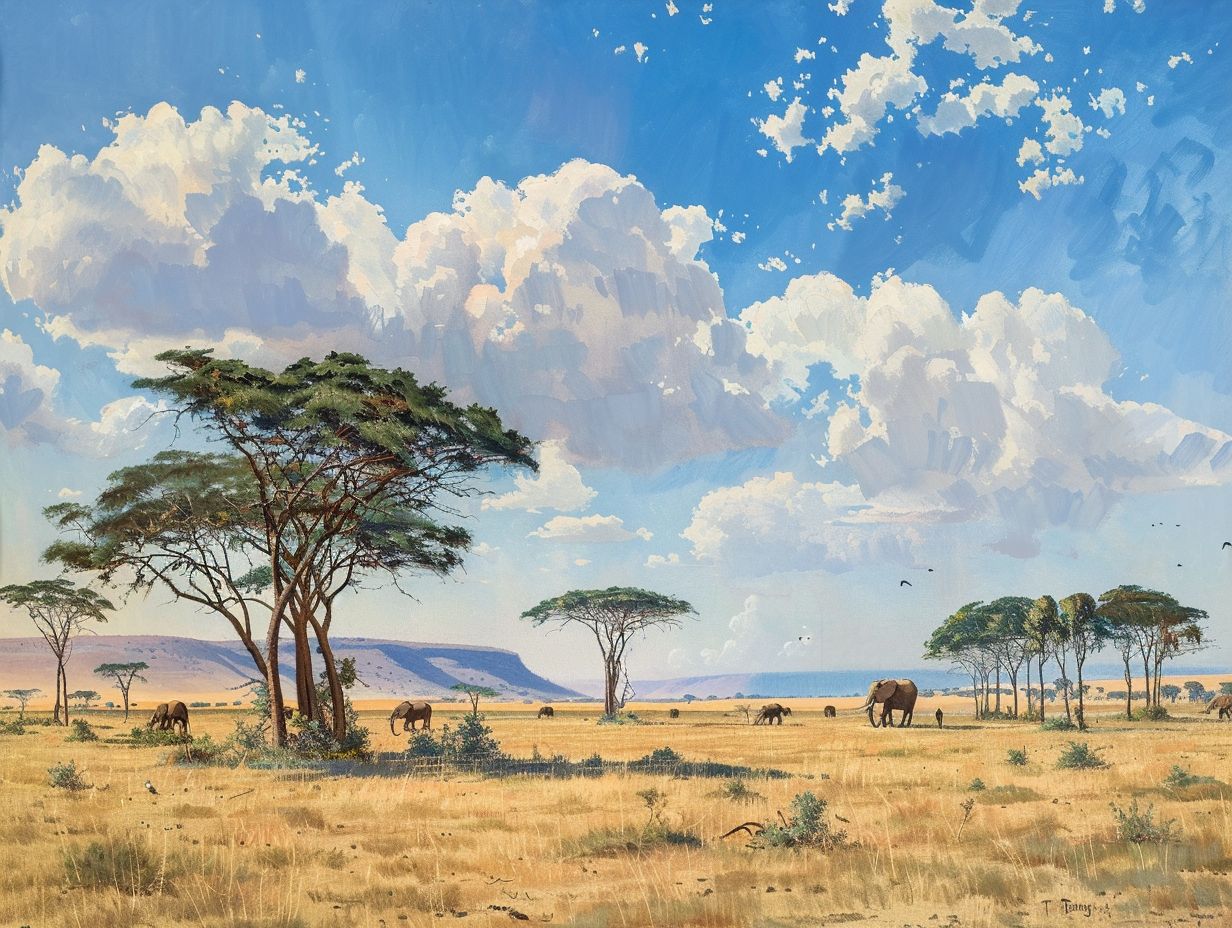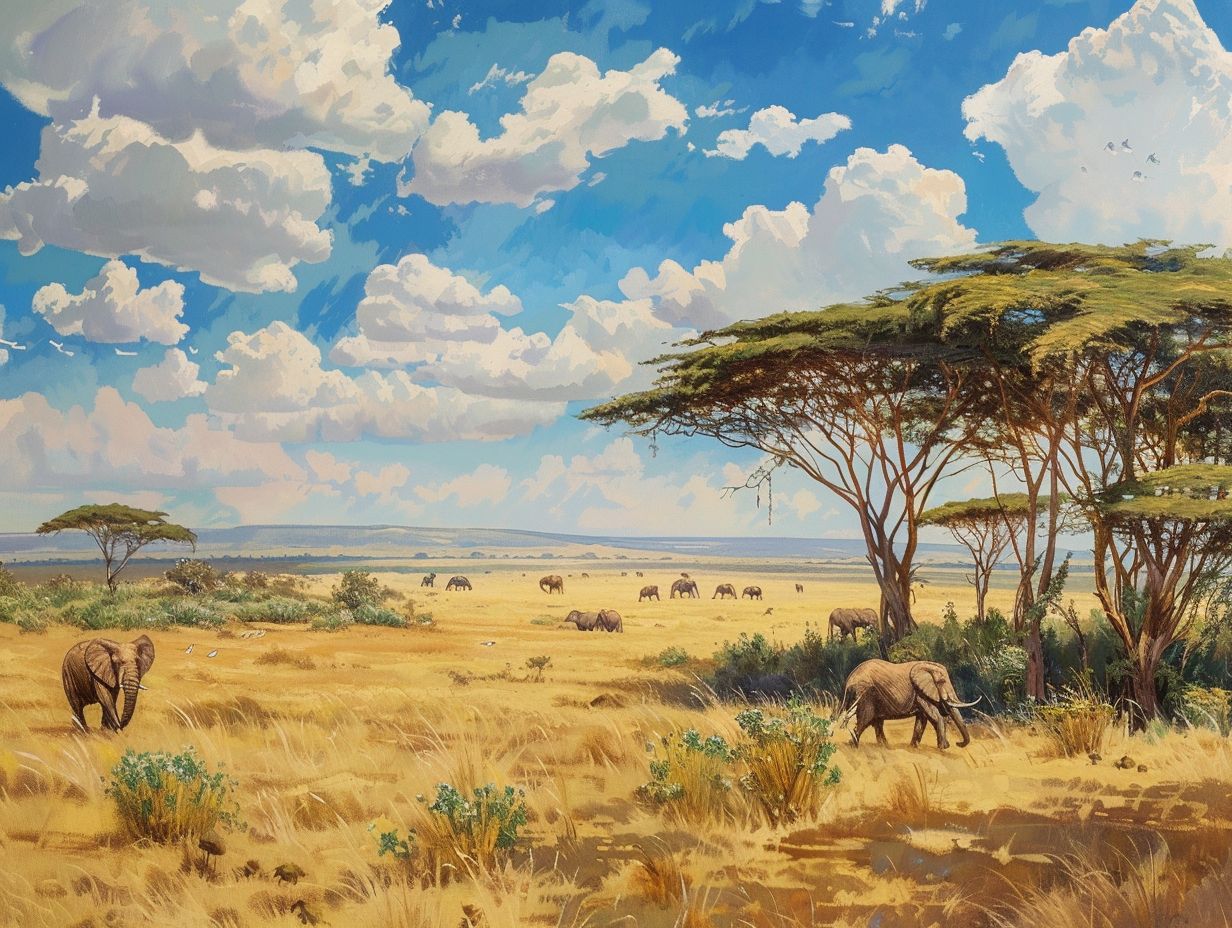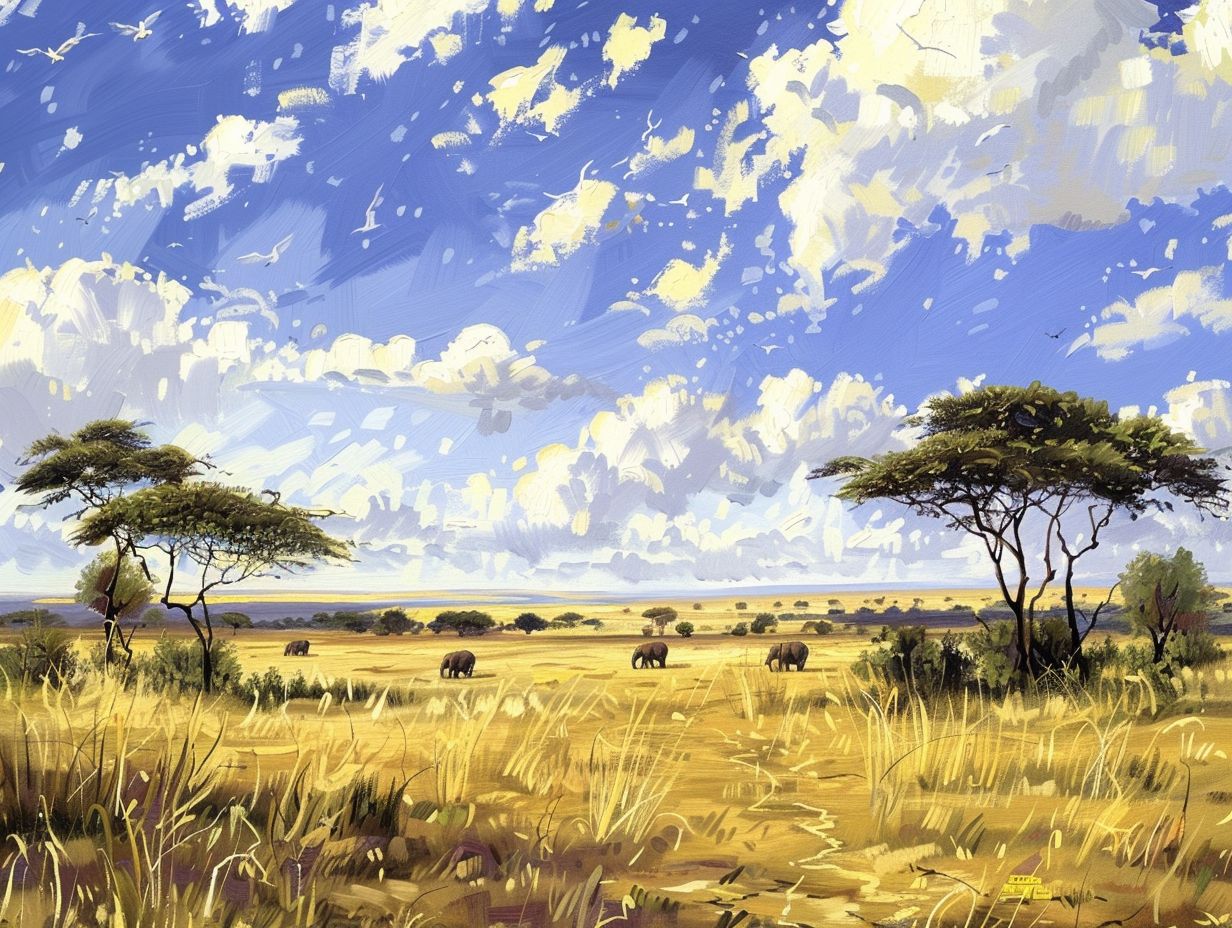
Tarangire National Park
Tarangire National Park, located in Tanzania, is a hidden gem waiting to be explored.
Explore the park’s rich history and unique features, including the famous Great Migration, towering Baobab trees, and diverse wildlife.
Discover the incredible animals that call Tarangire home, from majestic elephants to elusive leopards.
Learn about the best times to visit the park and the exciting activities available, such as game drives, walking safaris, bird watching, and cultural visits.
Join us as we uncover the wonders of Tarangire National Park.
Key Takeaways:

- Tarangire National Park is located in Tanzania, known for its diverse wildlife and stunning baobab trees.
- The park is home to the Great Migration, where thousands of animals migrate through the area.
- Visitors can spot elephants, lions, giraffes, leopards, and zebras in their natural habitats.
Location and History of Tarangire National Park
Located in the Manyara Region of Tanzania, Tarangire National Park is known for its diverse wildlife and the Tarangire River flowing through it.
The park’s history dates back to its establishment as a protected area in 1970, aimed at preserving the unique ecosystems and species found within its borders.
Over the years, the Tarangire River has played a crucial role in sustaining the rich biodiversity of the park, attracting numerous animals.
The park’s proximity to both Manyara Region and Arusha positions it strategically as part of the larger conservation area.
The establishment of Tarangire National Park has been a significant landmark in Tanzania’s conservation efforts, highlighting the nation’s commitment to preserving its natural heritage.
What Makes Tarangire National Park Unique?
Tarangire National Park stands out for its remarkable combination of abundant wildlife, including large elephant herds, and the iconic presence of ancient baobab trees scattered across the landscape.
1. The Great Migration
Tarangire National Park is witness to the Great Migration, a spectacular natural phenomenon where vast herds of wildebeest and zebras traverse the plains.
This awe-inspiring event occurs annually, drawing travelers and wildlife enthusiasts from around the globe to witness this remarkable journey of thousands of animals across the savannah.
The migration is driven by the need for food and water, pushing the herds to cover vast distances, testing their stamina and adaptability to the changing landscapes.
The influx of wildebeest and zebras has a profound impact on the ecosystem of Tarangire National Park, enriching the biodiversity.
This cyclical movement plays a vital role in maintaining the delicate balance of nature within the park.
2. The Baobab Trees
One of the defining features of Tarangire National Park is the presence of majestic baobab trees that dot the landscape, adding a sense of ancient grandeur.
These iconic trees play a crucial role in shaping the park’s unique vegetation and sustaining its wildlife.
The baobab trees, with their massive trunks and distinctive silhouette, act as pillars of the ecosystem, offering shelter.
Birds utilize their sturdy branches for nesting, while elephants, known for their fondness of baobab fruits, contribute to seed dispersal.
The hollowed trunks of baobabs serve as natural shelters for various creatures, from bats to small mammals, enhancing the park’s biodiversity.
3. The Diverse Wildlife
Tarangire National Park boasts a diverse array of wildlife, including iconic species such as lions, leopards, cheetahs, and African wild dogs.
The presence of these majestic predators adds a thrilling dimension to the park’s wildlife encounters.
The lions in Tarangire National Park are not only a sight to behold but also play a crucial role in maintaining the park’s ecosystem balance.
Their powerful roars can often be heard resonating across the savannah, marking their territory and asserting their dominance.
Leopards, with their elusive nature, provide visitors with a sense of mystery and excitement as they glimpse these solitary creatures resting in the trees.
What Animals Can Be Found in Tarangire National Park?

Tarangire National Park is home to a diverse range of animals, from large herds of elephants and prides of lions to graceful giraffes and zebras.
1. Elephants
Elephants are one of the star attractions in Tarangire National Park, known for their large herds and unique behavior.
The park is renowned for its high elephant population, offering visitors the chance to witness rare occurrences like twin elephant births in the wild.
These intelligent and majestic creatures exhibit complex social structures, living in matriarchal herds led by the oldest female.
The bond within elephant families is strong, with members communicating through a variety of sounds and body language.
Regarding feeding habits, elephants are herbivores, consuming a vast quantity of vegetation daily, shaping the landscape as they move through the park.
Their breeding patterns are also fascinating, with females giving birth to a single calf after a gestation period of around 22 months.
One of the notable highlights of Tarangire is the successful twin elephant births, a rare spectacle that showcases the park’s thriving ecosystem.
Conservation efforts are crucial to protect these gentle giants, as they face threats such as poaching and habitat loss.
Tarangire National Park plays a vital role in safeguarding elephants and raising awareness about the importance of preserving their natural habitat.
2. Lions
Lions, as apex predators, play a crucial role in maintaining the ecological balance of Tarangire National Park.
These majestic big cats are not only a symbol of wilderness but also serve as indicators of the park’s conservation success in preserving their habitats.
Known for their strategic hunting behaviors, lions exhibit remarkable coordination within their prides when pursuing prey, showcasing their superior teamwork.
The social structure of lion prides, led by a dominant male and supported by lionesses, contributes to the park’s biodiversity.
With the decline in lion populations globally, conservation efforts in Tarangire National Park have become pivotal.
Various organizations collaborate to monitor and protect these majestic felines, safeguarding their presence in the ecosystem .
3. Giraffes
Giraffes grace the landscapes of Tarangire National Park with their elegant presence and unique charm.
The park is also known for hosting rare sightings of the elusive white giraffe, a phenomenon that has intrigued researchers and wildlife enthusiasts alike.
The giraffes in Tarangire National Park play a vital role in the ecosystem through their feeding behaviors.
These majestic creatures have a specialized diet primarily consisting of leaves, twigs, and fruits found on the tall acacia trees.
Their long necks and tongues help them reach high branches, making them the iconic browsers of the savannah.
In terms of social dynamics, giraffes are often seen in small groups known as towers, which provide protection against predators.
4. Leopards
Leopards, with their elusive nature and exceptional hunting skills, thrive in the diverse habitats of Tarangire National Park.
These stealthy big cats rely on their camouflage and agility to navigate the park’s terrain, offering visitors rare glimpses into their secretive lives.
These majestic predators exhibit a remarkable adaptability to their environment, preferring areas with dense vegetation for concealment.
Their hunting techniques are a blend of stealth and precision, utilizing ambush strategies to surprise their prey.
Leopards play a crucial role in maintaining the balance of the ecosystem by controlling the population of herbivores.
5. Zebras
Zebras, with their striking black-and-white stripes, form vibrant herds that traverse the savannahs of Tarangire National Park.
The park is witness to the beautiful spectacle of zebra births, a natural occurrence that underscores the circle of life within the park’s dynamic ecosystem.
Zebras are highly social animals, known to live in tight-knit groups or ‘harems,’ consisting of a dominant male, several females, and their young.
These herds not only provide protection against predators but also facilitate better foraging opportunities.
The migratory patterns of zebras play a crucial role in maintaining the biodiversity of the park. Grazing on different grasses helps prevent overgrazing.
When is the Best Time to Visit Tarangire National Park?

The best time to visit Tarangire National Park largely depends on the season, with the dry season from June to October offering optimal wildlife viewing.
In contrast, the wet season from November to May transforms the park into a lush paradise with vibrant vegetation and migratory bird species.
During the dry season, the sparse vegetation and limited water sources lead animals to congregate around the Tarangire River.
1. Dry Season (June – October)
The dry season in Tarangire National Park heralds the arrival of large herds of animals seeking water along the Tarangire River.
This period offers excellent game viewing opportunities as wildlife congregates around the riverbanks and waterholes.
During this time, the iconic baobab trees, which dot the landscape of the park, stand out against the arid savannah, creating a picturesque setting for observation.
The Tarangire River becomes a lifeline, attracting elephants, zebras, wildebeests, and various antelope species that rely on its waters.
Animal migrations in Tarangire National Park during the dry season are a spectacle to behold, with species like wildebeests and elephants traveling long distances.
The dynamics of the water sources play a crucial role in shaping the movements and behaviors of wildlife, illustrating the interconnectedness of the ecosystem.
2. Wet Season (November – May)
The wet season transforms Tarangire National Park into a verdant paradise, with lush vegetation and blooming flowers adorning the landscape.
The park’s swamps come alive with bird species, attracting birdwatchers and nature enthusiasts keen on exploring the avian diversity of the region.
The abundance of rainfall during this period not only sustains the park’s ecosystem but also creates picturesque scenes of flowing streams.
The wetlands provide a vital habitat for various water-dependent species, including elephants, zebras, and buffalo, which find ample food and water resources.
The increased water levels also give rise to vibrant fish populations, further enriching the park’s ecological balance.
What Are the Activities Available in Tarangire National Park?
Tarangire National Park offers a diverse range of activities for visitors, birdwatching expeditions, and cultural visits to Maasai communities.
The park’s well-equipped lodges provide comfortable accommodations for travelers looking to explore its wonders.
1. Game Drives
Game drives in Tarangire National Park are an exhilarating way to explore the vast landscapes and encounter the diverse wildlife that thrives in the park.
From elephants and lions to zebras and giraffes, these safaris offer unforgettable wildlife viewing experiences for visitors of all ages.
Imagine the thrill of spotting a majestic elephant lumbering gracefully across the savannah or witnessing a pride of lions relaxing under the shade.
Tarangire National Park is also known for its abundant birdlife, with colorful species like lilac-breasted rollers and yellow-collared lovebirds gracing the skies.
During a game drive, skilled guides provide fascinating insights into the behavior and habits of the park’s residents, adding depth to your wildlife encounters.
Their expertise enhances your experience as they navigate the terrain to maximize your chances of seeing elusive predators or rare species.
2. Walking Safaris
Walking safaris offer a unique perspective of Tarangire National Park, allowing visitors to experience the sights, sounds, and scents of the wilderness up close.
Guided by knowledgeable rangers, these safaris offer insights into the park’s flora, fauna, and the ancient baobab trees that dot the landscape.
As you traverse through the park on foot, every step immerses you deeper into nature, creating a profound connection with the environment around you.
The ranger-guided tours not only enhance your understanding of the ecosystem but also educate you on the importance of wildlife conservation.
Encounters with wildlife become intimate as you observe animals in their natural habitat, from elegant giraffes to herds of elephants roaming freely.
The iconic baobab trees stand as ancient sentinels, casting their majestic shadows and adding a sense of wonder to your safari experience.
Amidst all this beauty, safety remains a top priority. Rangers are well-trained in wildlife behavior and equipped to handle any potential encounters.
Precautions such as maintaining a safe distance from animals and following designated paths ensure a secure and memorable safari adventure.
3. Bird Watching

Tarangire National Park is a paradise for birdwatchers, with its diverse habitats supporting a rich avian population.
From colorful bee-eaters to majestic raptors, the park offers bird enthusiasts the opportunity to spot a wide variety of species.
One of the best birding spots in Tarangire National Park is the Silale Swamp, where water-loving species like herons, storks, and African fish eagles can be seen.
The dense woodlands and baobab trees are also crucial habitats for woodland species such as hornbills and barbets.
What makes birdwatching in Tarangire truly special is its seasonal migrations, with European migrants joining local residents during the dry season.
Conservation efforts play a vital role in safeguarding these incredible bird populations and their habitats.
Cultural Visits
Cultural visits to Maasai communities near Tarangire National Park offer a glimpse into the traditional way of life and rich heritage of the Maasai people.
Engaging with the local community provides visitors with a unique opportunity to understand the Maasai culture firsthand.
By interacting with the Maasai people, tourists can gain insights into their daily rituals, traditional attire, and age-old practices.
Participating in cultural exchange programs fosters mutual respect and appreciation between visitors and the Maasai community.
This symbiotic relationship benefits both parties, as tourists gain a deeper understanding of Maasai traditions while the local community receives economic support.
Frequently Asked Questions
1. What is Tarangire National Park?
A: Tarangire National Park is a national park in Tanzania known for its diverse wildlife and stunning landscapes.
2. How big is Tarangire National Park?
A: Tarangire National Park covers an area of approximately 2,600 square kilometers.
3. What kind of animals can I see in Tarangire National Park?
A: Tarangire National Park is home to a wide variety of animals, including elephants, lions, giraffes, zebras, and over 550 species of birds.
4. When is the best time to visit Tarangire National Park?
A: The best time to visit Tarangire National Park is during the dry season from June to October, when the wildlife congregates around the Tarangire River.
5. Are there any accommodations available in Tarangire National Park?
A: Yes, there are several lodges and campsites within the park, as well as nearby towns with hotels and guesthouses.
6. What activities can I do in Tarangire National Park?
A: Visitors to Tarangire National Park can go on game drives, bird watching, nature walks, and even hot air balloon safaris.